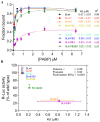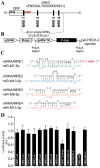Poly(A) binding protein 1 enhances cap-independent translation initiation of neurovirulence factor from avian herpesvirus
- PMID: 25503397
- PMCID: PMC4263670
- DOI: 10.1371/journal.pone.0114466
Poly(A) binding protein 1 enhances cap-independent translation initiation of neurovirulence factor from avian herpesvirus
Abstract
Poly(A) binding protein 1 (PABP1) plays a central role in mRNA translation and stability and is a target by many viruses in diverse manners. We report a novel viral translational control strategy involving the recruitment of PABP1 to the 5' leader internal ribosome entry site (5L IRES) of an immediate-early (IE) bicistronic mRNA that encodes the neurovirulence protein (pp14) from the avian herpesvirus Marek's disease virus serotype 1 (MDV1). We provide evidence for the interaction between an internal poly(A) sequence within the 5L IRES and PABP1 which may occur concomitantly with the recruitment of PABP1 to the poly(A) tail. RNA interference and reverse genetic mutagenesis results show that a subset of virally encoded-microRNAs (miRNAs) targets the inhibitor of PABP1, known as paip2, and therefore plays an indirect role in PABP1 recruitment strategy by increasing the available pool of active PABP1. We propose a model that may offer a mechanistic explanation for the cap-independent enhancement of the activity of the 5L IRES by recruitment of a bona fide initiation protein to the 5' end of the message and that is, from the affinity binding data, still compatible with the formation of 'closed loop' structure of mRNA.
Conflict of interest statement
Figures








Similar articles
-
Identification of a neurovirulence factor from Marek's disease virus.Avian Dis. 2013 Jun;57(2 Suppl):387-94. doi: 10.1637/10322-080912-Reg.1. Avian Dis. 2013. PMID: 23901751
-
The 5' leader of the mRNA encoding the marek's disease virus serotype 1 pp14 protein contains an intronic internal ribosome entry site with allosteric properties.J Virol. 2009 Dec;83(24):12769-78. doi: 10.1128/JVI.01010-09. Epub 2009 Sep 30. J Virol. 2009. PMID: 19793814 Free PMC article.
-
Stimulation of translation by human Unr requires cold shock domains 2 and 4, and correlates with poly(A) binding protein interaction.Sci Rep. 2016 Mar 3;6:22461. doi: 10.1038/srep22461. Sci Rep. 2016. PMID: 26936655 Free PMC article.
-
[Translational control by the poly(A) binding protein: a check for mRNA integrity].Mol Biol (Mosk). 2006 Jul-Aug;40(4):684-93. Mol Biol (Mosk). 2006. PMID: 16913227 Review. Russian.
-
The IRE (iron regulatory element) family: structures which regulate mRNA translation or stability.Biofactors. 1993 May;4(2):87-93. Biofactors. 1993. PMID: 8347279 Review.
Cited by
-
Seneca Valley virus 3Cpro antagonizes host innate immune responses and programmed cell death.Front Microbiol. 2023 Oct 6;14:1235620. doi: 10.3389/fmicb.2023.1235620. eCollection 2023. Front Microbiol. 2023. PMID: 37869659 Free PMC article. Review.
-
Alphaherpesvirus Subversion of Stress-Induced Translational Arrest.Viruses. 2016 Mar 15;8(3):81. doi: 10.3390/v8030081. Viruses. 2016. PMID: 26999187 Free PMC article. Review.
-
The 5'-poly(A) leader of poxvirus mRNA confers a translational advantage that can be achieved in cells with impaired cap-dependent translation.PLoS Pathog. 2017 Aug 30;13(8):e1006602. doi: 10.1371/journal.ppat.1006602. eCollection 2017 Aug. PLoS Pathog. 2017. PMID: 28854224 Free PMC article.
-
Messenger RNAs of Yeast Virus-Like Elements Contain Non-templated 5' Poly(A) Leaders, and Their Expression Is Independent of eIF4E and Pab1.Front Microbiol. 2019 Oct 30;10:2366. doi: 10.3389/fmicb.2019.02366. eCollection 2019. Front Microbiol. 2019. PMID: 31736885 Free PMC article.
-
Translational Control in Virus-Infected Cells.Cold Spring Harb Perspect Biol. 2019 Mar 1;11(3):a033001. doi: 10.1101/cshperspect.a033001. Cold Spring Harb Perspect Biol. 2019. PMID: 29891561 Free PMC article. Review.
References
Publication types
MeSH terms
Substances
Grants and funding
LinkOut - more resources
Full Text Sources
Other Literature Sources
Research Materials
Miscellaneous

